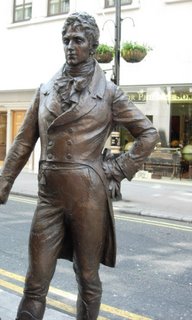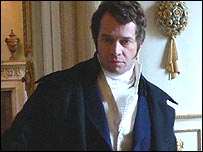 We welcome–or rather, welcome back, since she’s a frequent visitor to the Riskies–Pam Rosenthal, acclaimed author of Almost a Gentleman and The Bookseller’s Daughter, whose next book THE SLIGHTEST PROVOCATION comes out this week.
We welcome–or rather, welcome back, since she’s a frequent visitor to the Riskies–Pam Rosenthal, acclaimed author of Almost a Gentleman and The Bookseller’s Daughter, whose next book THE SLIGHTEST PROVOCATION comes out this week.
Enter your comment or question for Pam (an intelligent, relevant one, please!) by Sunday, September 10 for a chance to win an autographed copy of The Slightest Provocation (winner to be chosen by the Riskies).
 Pam Rosenthal’s writing is extraordinary. Fans of Laura Kinsale and Julia Ross will adore Rosenthal’s ability to humanize her characters–to render their emotions and reactions realistic to a fault, while maintaining a warmth that makes them sympathetic. Kit and Mary breathe. Louisa White, Fresh Fiction
Pam Rosenthal’s writing is extraordinary. Fans of Laura Kinsale and Julia Ross will adore Rosenthal’s ability to humanize her characters–to render their emotions and reactions realistic to a fault, while maintaining a warmth that makes them sympathetic. Kit and Mary breathe. Louisa White, Fresh Fiction
Thoroughly grounded in history and threaded through with breathtaking sensuality, this intelligent, well-crafted romance takes readers on a fascinating journey and will appeal to those who appreciate a bit more history with an erotic, literary touch. Library Journal
Rosenthal crafts a tantalizing tale about a fiery love/hate relationship that defies the boundaries of love. Her strong characters’ fierce desires will leave readers panting. FOUR STARS Kathe Robin, Romantic Times
Pam, congratulations on the great reviews. Tell us what The Slightest Provocation is about.
It’s about a pair of lovers who eloped and then separated, when they were too young and feckless to know how to handle their youth, passions, and conflicting values. Since then, Mary has lived an independent life among poets and reformers, while Kit has learned discipline and responsibility in the army. Now that the war with Napoleon is over, they find themselves thrust back together.
The thrusting part (no surprise) works quite as well as it ever did. But the two of them still can’t agree on much else, especially disagreeing about the current political situation. The turning point is their discovery of a secret government plot, which forces them to question what’s truly important and to rethink their places in the world and with each other. The government plot really happened, by the way, and I find it quite fascinating.
So it’s about the varieties of power–erotic and otherwise. And also about love and the effects of time (inevitable, I suppose, since I’m not getting any younger myself).
What inspired you to write it?
First off, there was my curiosity–the urge that I share with you Riskies, to peek beyond the gates of the landed estate or the boundaries of Mayfair and St. James, to see what else was going on. And what I found, in the years after 1815, was a British Home Office most vexed by the parliamentary reform societies springing up throughout the country. The government responded to the situation by suspending habeas corpus, limiting the right to assemble, and sending a shady agent provocateur to foment rebellion and thus discredit the reformers. You can see it happening, if you read the Home Office correspondence in the British National Archives.
Added to which there’s my continuing interest, as an erotic writer, with point of view and the power of looking–which in this case led to a fascination with espionage. What’s wonderful to me is that while many things changed in the writing of this book, the founding image remains just as I first conceived it: an Englishman hidden in shadow, watching an Englishwoman, rather the worse for a hard day of travel, stepping out of a coach into an inn yard at Calais. I wondered if this was an image of the man’s power as a viewer, or of his powerlessness to stop looking. I was enthralled by the ambiguity, and what it implied for the volatility of an erotic relationship. And I think I must have gotten something of my obsession across, though, because an early reviewer (Historical Romance Writers–read the full review here) has said that she felt like a voyeur at Mary and Kit’s clandestine meetings.
Describe the challenge of using all that historical actuality, as you call it.
Whew! Well, besides getting it all right, you mean? (I’m adding an errata section to my web page, to deal with my errors as they’re revealed, by the way). But the ongoing problem was that I committed to following the true day-to-day chronology of events. Which meant I had to engineer the unfolding of the erotic connection to make sense in the context of Mary and Kit’s discoveries and varying interpretations. Since pacing is so critical in erotic writing, this set some serious constraints on what I could do. On the other hand, constraint, secrecy, and the nuances of understanding can be very sexy. One makes do.
Tell us a bit about the historical background/research you did.
Well, there were three parts to it. The early, difficult part was simply to unravel an intrigue that might have been hatched by Scooter Libbey, only in 1817. My husband Michael did yeoman labor in helping me put the pieces together, trucking home books from several libraries, finding the references to the Home Office documents, getting us permits to use the British Library and National Archives… but I did write the book, I promise.
 The fun part was going to the Derbyshire countryside, where the agent provocateur made the most trouble–and where Mary and Kit grew up together. We spent a week tramping through fields and forests (my couple has lots of clandestine forest meetings)–I know, it’s a dirty job but someone has to do it. It’s a lovely area; we stayed at the village of Youlgrave (left), which is very near Chatsworth, and I highly recommend it. We got lost on our way to Pentrich, some twenty miles away, where some of the events would have happened. Which incident became story fodder–well, have you ever met a married couple who didn’t quarrel under such circumstances, especially if the guy refuses to ask directions?
The fun part was going to the Derbyshire countryside, where the agent provocateur made the most trouble–and where Mary and Kit grew up together. We spent a week tramping through fields and forests (my couple has lots of clandestine forest meetings)–I know, it’s a dirty job but someone has to do it. It’s a lovely area; we stayed at the village of Youlgrave (left), which is very near Chatsworth, and I highly recommend it. We got lost on our way to Pentrich, some twenty miles away, where some of the events would have happened. Which incident became story fodder–well, have you ever met a married couple who didn’t quarrel under such circumstances, especially if the guy refuses to ask directions?
But in some ways the most thrilling part was spent in the British Library and especially the National Archives, where we saw the correspondence between the Home Office, its agents and the magistrates. We were scared that we wouldn’t be able to decipher the old handwriting (though we didn’t admit that to each other until we were seated in front of the microfiche machines). But we could–not every word, but lots. And there it was, Lord Sidmouth, the Home Office Secretary, telling the magistrates not to arrest the provocateur. “A smoking gun,” Michael whispered.
How does this book take risks?
I don’t tell the erotic love story through a completely straightforward chronology. Kit and Mary’s earlier relationship–childhood, impetuous adolescence, elopement, early marriage, indiscretions, and betrayals–are rendered through memory fragments, breaking the surface of consciousness in that weird way that memory has. Which means that sometimes an incident will be told twice, from he says/she says contrasting points of view, and that events aren’t always recounted in chronological order. So I was concerned that I was asking a lot of my readers, to put it all together–though I do think there’s a coherent, compelling story to be found (and one that demands some compassion: this is a pair of lovers who hurt each other deeply when they were young and out of control). On the other hand, I’m a firm believer that a book comes alive through a reader’s active involvement in it. And since the story the reader has to piece together is a sexy, passionate one, I hoped that would be a motivation, and ultimately its own reward. And I think I might have pulled it off.

 Kelly states that Brummell “wore slim-cut trousers or ‘pantaloons’ that flattered his famously long-legged frame. For daywear these were made of leather, mercerized cotton, or nankeen and plain cotton in summer. Evening wear necessitated black, according to the new asthetic, and Brumell wore sheer black silk jersey, made up as breeches for Carlton House or the theatre, and as pantaloons for the clubs.”
Kelly states that Brummell “wore slim-cut trousers or ‘pantaloons’ that flattered his famously long-legged frame. For daywear these were made of leather, mercerized cotton, or nankeen and plain cotton in summer. Evening wear necessitated black, according to the new asthetic, and Brumell wore sheer black silk jersey, made up as breeches for Carlton House or the theatre, and as pantaloons for the clubs.”







